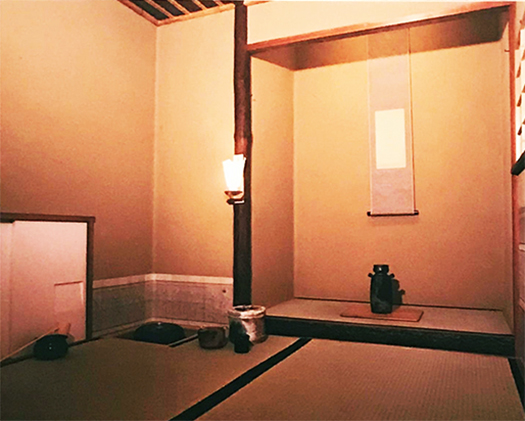

写真は堺市博物館展示で見た「大阪城山里二畳敷き」復元茶室。
利休の待庵は大山崎にあるけれど秀吉は政戦に忙しく訪れなかったといわれる。
ようやく大坂築城の段階になって、利休に城内の山里に草庵建築を命じたとされる。
なので当然、大阪の陣などの戦乱で焼失したようですが復元されている。
この戦国末期で日本の建築文化は大きく変化した。
信長を始めとした権力者が朝廷や幕府体制とは異質な堺町衆茶の湯を中心とした
あらたな価値感を積極的に導入し、その価値感の拡散を行った。
信長は茶道具などを政戦の道具にしていって戦功を立てた武者に
茶道具を与えたりして、コスパのいい報奨制度を作っていった。
驚くことにそれを喜んでいた家臣がいたとも言う。
信長は芸術への感受性を持った存在だとは思うけれど利用の仕方ももあざとい。
茶道具は結局はお金の世界。交易重視の織田政権が現実に天下統一したら
1500年代にも日本は世界史のプレーヤーとして出現し、
その重商主義政策で歴史はどうなっていったか。
しかし、秀吉政権の朝鮮出兵とその後の状況が同じように展開したとも思える。
信長は死ぬべくして死んだのかも知れない。
本能寺で横死しなくとも結局は家康的政権が最終的に生き残った可能性が高い。
茶道具・茶の湯文化というものが権力によって認証されて価値を得たことは事実。
文化が物理的価値化したことで日本では住文化も特異な発達があったと思える。
茶室的審美眼への右ならえが深く進行したのではないだろうか。
今日のメディアでの目に余る大衆扇動を見ると日本的なるものが見えてくる・・・。
そういう文化が先鋭化して利休のような天才を生みだし、
その政治文化的有用性に惹かれ秀吉政権は深く利用しまくったのでしょう。
そして秀吉と衝突し切腹させられたことで逆に永遠の命を得た。
一種の精神的権威付けが完了してしまったのだと思える。
ちょうどキリストが磔の刑に処されてその教えが永遠の光沢をまとったように。
むしろそこから茶の湯とか、わびさびとかの精神性で彩られた茶道が
日本文化の極地的な輝きを放ち続けたのだと思う。
独特の「数寄屋建築」という住宅文化が根深く成立した。
利休の草庵茶室の考え方には、きわめて精神性優位の考えが貫かれ、
寒さ暑さすらも、むしろそれを耐えて精神性を高めるのだというような種類の
無意識のバイアスが日本住宅文化全体に及んだのではないだろうか。
茶の湯文化と同根と思える数寄屋建築は人間の皮膚感覚よりも
精神性に優位性を見出して、カタチとしてのしきたりとか、
作法とか、表面的な部分に建築発展を閉じ込めた側面があったのだと思える。
いわば利休的天才の狂気が現実の常識世界に勝るのだと刷り込まれた。
・・・いま北海道で住宅を取材していると、床の間も、いや畳の部屋すら
きれいさっぱりと存在せず、また茶室に特徴的な「深い軒の出」もない
無落雪ののっぺりとしたハコの家が林立している、とも見える。
内部空間の温熱品質という常識的な最上位価値に率直なのだと思う。
その段階から民族的DNAの発露があってどんな空間が今後生成していくか、
興味深い局面ではないかと思い続けている次第です。
茶の湯でも利休のような天才革命者がふたたび現れ高断熱高気密の2畳の空間を
思わぬ芸術家的狂気を感じさせるものとして
厳寒の地で花開かせるかも知れない。ひそかに期待している。
English version⬇
[Tea room / Sukiya living culture DNA / Japanese good house special edition ㊱-12]
The photo shows the restored tea room of “Osaka Shiroyama-ri 2 tatami mats” seen at the Sakai City Museum exhibition.
Rikyu’s waiting hermitage is in Oyamazaki, but Hideyoshi is said to have been busy with the political war.
It is said that Rikyu ordered Rikyu to build Soan in the mountain village of the castle at the stage of the construction of Osaka Castle.
So, of course, it seems that it was burnt down in the war of the Osaka team, but it has been restored.
At the end of the Warring States period, Japanese architectural culture changed drastically.
Nobunaga and other powerful people focused on the Sakai-cho Shucha-no-Yu, which is different from the imperial court and the shogunate system.
We actively introduced a new sense of value and spread that sense of value.
Nobunaga became a samurai who made a war by using tea utensils as a tool for political warfare.
He gave tea utensils and created a good reward system for cospa.
Surprisingly, there was a vassal who was pleased with it.
I think Nobunaga is sensitive to art, but he has a lot of ways to use it.
Tea utensils are the world of money after all. If the trade-oriented Oda administration actually unifies the world
Japan emerged as a player in world history in the 1500s,
What happened to history with that mercantilist policy?
However, it seems that the Hideyoshi administration’s dispatch to Korea and the situation after that developed in the same way.
Nobunaga may have died to die.
It is highly possible that the Ieyasu administration eventually survived even if he did not die sideways at Honnoji.
It is a fact that the tea utensils and tea ceremony culture have been certified by power and gained value.
As the culture became a physical value, it seems that the living culture also had a peculiar development in Japan.
It seems that the right-hand side of the tea room-like aesthetics has progressed deeply.
Looking at the instigation of the mass media by today’s media, you can see something Japanese.
That kind of culture has sharpened and created a genius like Rikyu.
The Hideyoshi administration must have used it deeply because of its political and cultural usefulness.
And by colliding with Hideyoshi and being seppuku, he gained eternal life.
It seems that a kind of mental authority has been completed.
Just as Christ was sentenced to crucifixion and his teachings wore eternal luster.
Rather, from there, the tea ceremony colored with the spirituality of Chanoyu and Wabi-Sabi
I think it continued to give off the polar brilliance of Japanese culture.
A unique housing culture called “Sukiya architecture” was deeply established.
The idea of Rikyu’s Kusan tea room is extremely spiritually superior.
The kind of thing that even the cold and heat endures and enhances spirituality.
Perhaps the unconscious bias has spread to the entire Japanese housing culture.
Sukiya architecture, which seems to have the same roots as the tea ceremony culture, is more than human skin sensation
Finding superiority in spirituality, customs as a form,
It seems that there was an aspect that confined the architectural development in the superficial part such as the manners.
It was imprinted that the madness of Rikyu genius was superior to the real world of common sense.
… When I’m covering a house in Hokkaido now, even the alcove, even the tatami room
It doesn’t exist cleanly, and there is no “deep eaves” that is characteristic of tea rooms.
It can also be seen that there are many Hako houses with no snowfall.
I think it is frank to the common sense top value of the thermal quality of the interior space.
What kind of space will be created in the future due to the exposure of ethnic DNA from that stage?
I keep thinking that it may be an interesting situation.
A genius revolutionary like Rikyu appears again in the tea ceremony, creating a highly insulated and airtight 2 tatami mat space.
As something that makes you feel unexpected artist madness
It may bloom in a cold region. I’m secretly expecting it.
Posted on 7月 17th, 2021 by 三木 奎吾
Filed under: 住宅マーケティング, 日本社会・文化研究







コメントを投稿
「※誹謗中傷や、悪意のある書き込み、営利目的などのコメントを防ぐために、投稿された全てのコメントは一時的に保留されますのでご了承ください。」
You must be logged in to post a comment.